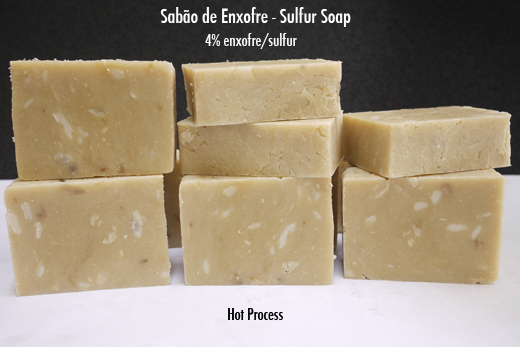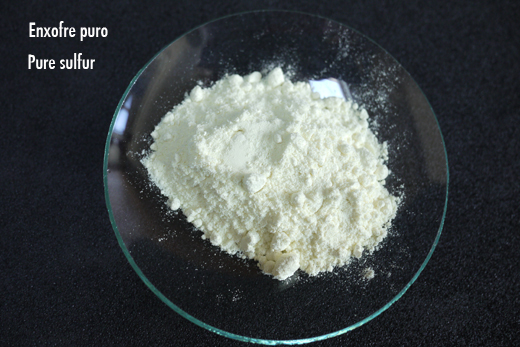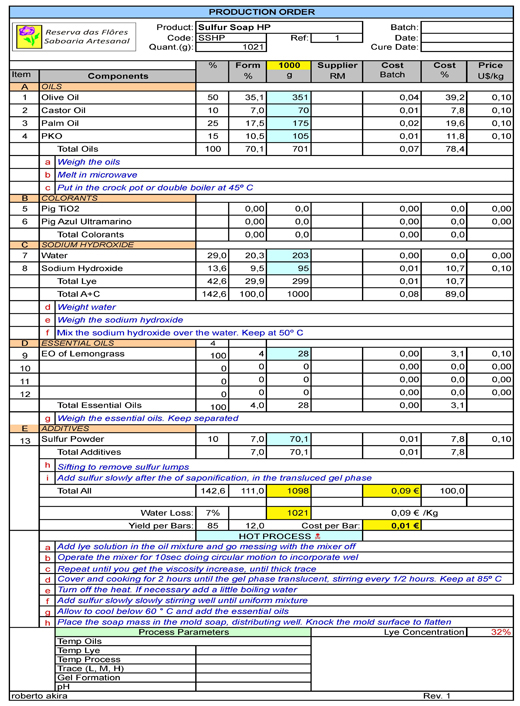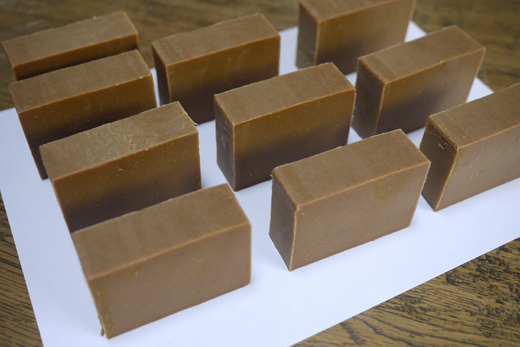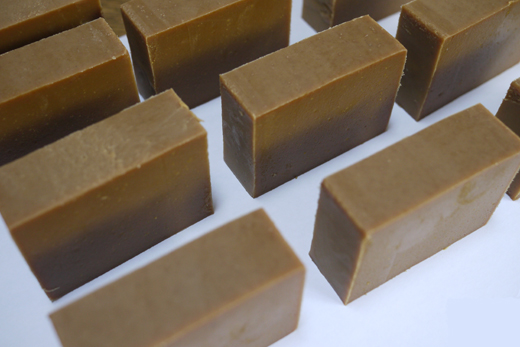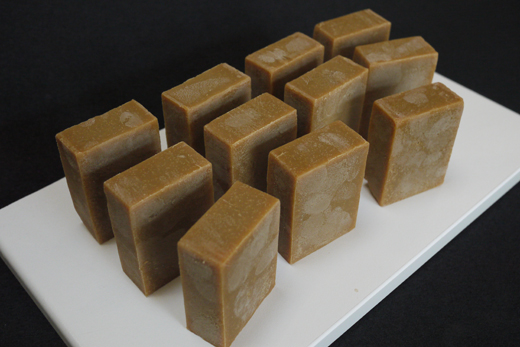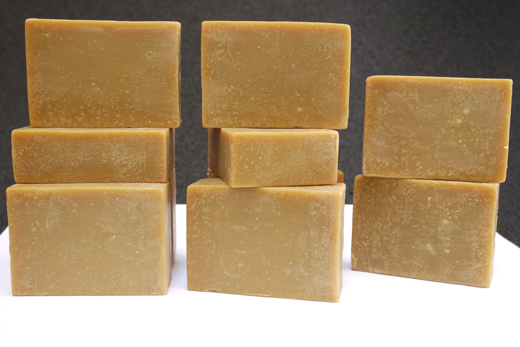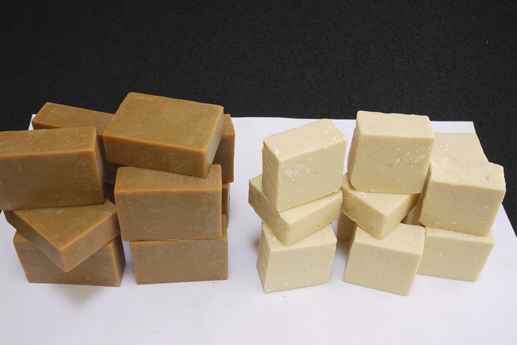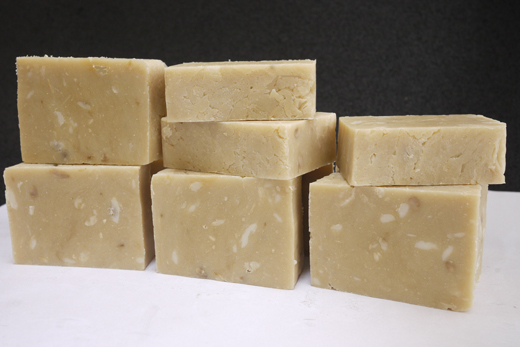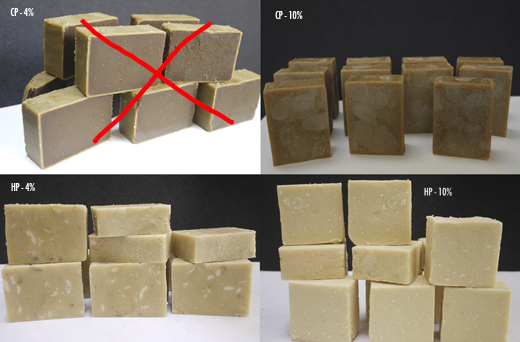 For many years the sulfur containing soap is recognized as effective in treating a variety of skin conditions, particularly in the reduction of acne. Here in Brazil the best known brand is the Granado, Confiânça in Portugal and Dr. Kauffman in the USA.
For many years the sulfur containing soap is recognized as effective in treating a variety of skin conditions, particularly in the reduction of acne. Here in Brazil the best known brand is the Granado, Confiânça in Portugal and Dr. Kauffman in the USA.
Usually offered with two doses of sulfur, typically 10% and 4% and with addition of salicylic acid. Has testimonials from people with very oily skin that usually take daily bath with 10% sulfur. The recommendation for the treatment of severe acne is to develop foam and pass that foam in the affected area and leave for a few minutes.
I decided to try to make this type of product in soap manufacture craft. In research that I did not find nothing anywhere that had a reference of how to make sulfur soap in the handmade scope. I imagine that the commercial products is a basic mass of soap is added sulfur and normal extrusion.
One caveat, as the post title says, this is a trial and did so many points are still in the realm of experience and are not fully understood. If you want to duplicate, is at your own risk.
Cold Process
I opted for the cold start process using the two doses of sulfur, 4 and 10%.The first question, how to add sulfur. Two modes, or mix in oils or add the trace. The sulfur is absolutely insoluble in water and an aggravation, or even can be dispersed in water simply do not mix and do not wetted by water, it is always supernatant. It is also not soluble in oils, it is more tolerant of wettability, but not dispersed well in oils.I chose to add the trace because it is already difficult to disperse in oils, imagine mixing the mass swelling in the trace.
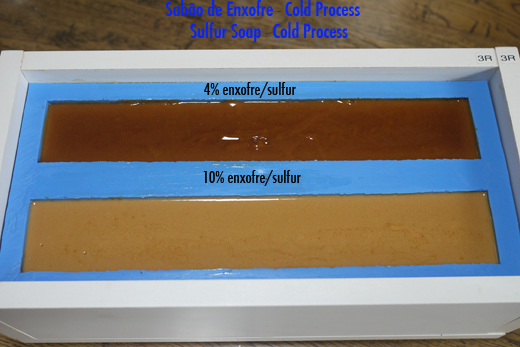 After 24 hours, the time of demolding, the soap with 4% sulfur was completely soft it was not possible to handle and had to wait 48 hours, but even so the soap was still soft and so remained until the end of 20 days. At first I could not understand what happened in this soap that was too soft and greasy, a sign that not all oils saponification.The soap was 10% normal with a reasonable hardness and it was then possible to cut.
After 24 hours, the time of demolding, the soap with 4% sulfur was completely soft it was not possible to handle and had to wait 48 hours, but even so the soap was still soft and so remained until the end of 20 days. At first I could not understand what happened in this soap that was too soft and greasy, a sign that not all oils saponification.The soap was 10% normal with a reasonable hardness and it was then possible to cut.
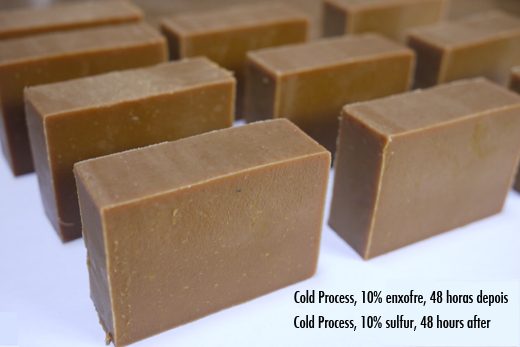 This soap with 10% sulfur as drying began to develop marks on the surface of the soap. These patches is sulfur powder that had migrated to the surface of the soap.
This soap with 10% sulfur as drying began to develop marks on the surface of the soap. These patches is sulfur powder that had migrated to the surface of the soap.
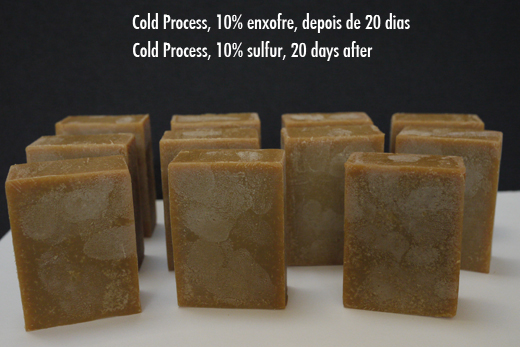 These stains can be removed with scraping and they have no tendency to return.
These stains can be removed with scraping and they have no tendency to return.
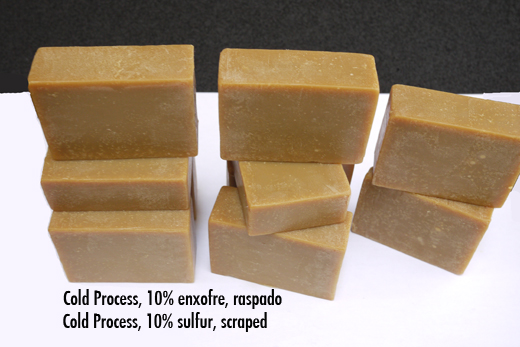 This soap with 10% sulfur, made by cold process has good characteristic has hardness makes a good foam and cleansing property is extremely high, very suitable for oily skin, typical of a sulfur soap.
This soap with 10% sulfur, made by cold process has good characteristic has hardness makes a good foam and cleansing property is extremely high, very suitable for oily skin, typical of a sulfur soap.
The soap containing 4% sulfur remains soft after 20 days and formed an interesting is that the outer layer and the inner yellowish acquired a very dark brown color. This layer of yellowish oil that is probably not saponificated. This may be due to lack of lye that may have been consumed in some interaction with sulfur, as strange as it may seem. This soap did not work and will be discarded
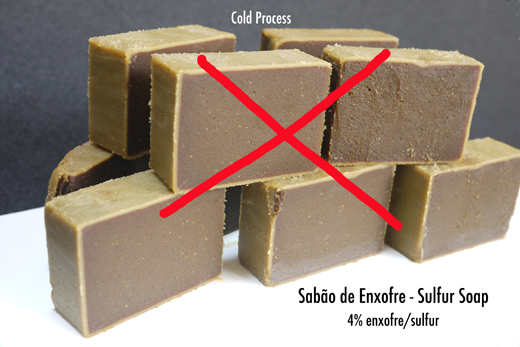 click here to download formula
click here to download formula
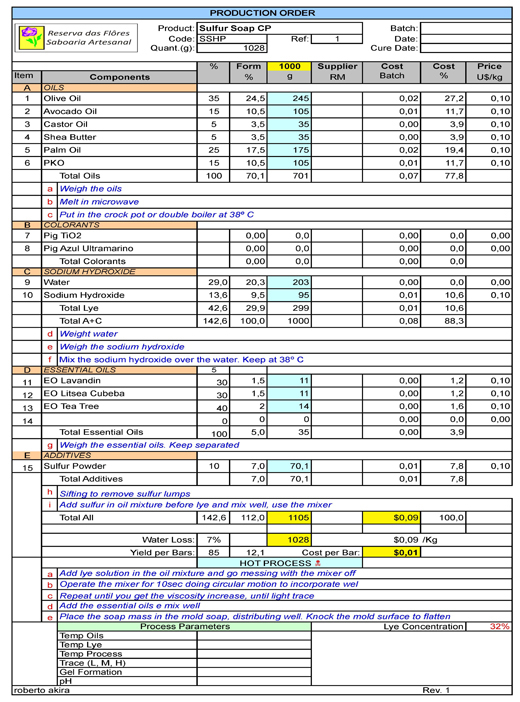 Hot Process
Hot Process
I changed the formulation to save the expensive oils and did a simple formula by removing the avocado oil and shea butter and increasing olive and castor oils. The process used was a conventional hot process using the slow-cooker (crock pot). The phase translucent gel was obtained within 2 hours of cooking. Divide the dough, a part in a water bath and the other remained in the slow-cooker. This water bath was added 10% sulfur and other 4%.
In both cases it was very difficult to incorporate the sulfur into the bulk of the hot process. Form is difficult to disperse clumps, even adding more hot water to the dough.
This 4% sulfur was added into the mixture remained in the pan at the bottom of the pan where the temperature is higher, the sulfur melted and formed dark brown lumps, typical of molten sulfur. Sulfur has a melting point around 112 ° C and forms a high viscosity liquid and dark brown. The white dots are mass with soap has not been mixed with the sulfur.
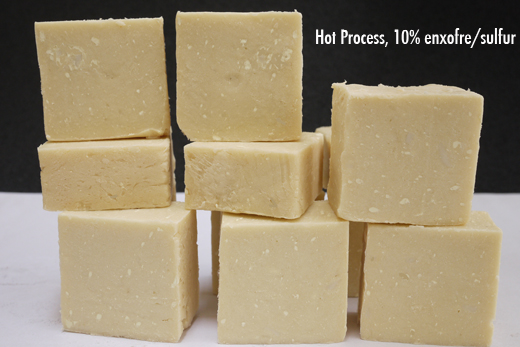 The two sulfur soap by hot process has good properties in general despite not looking very uniform due to the mass of white dots not mixed with sulfur and dark spots due to the fusion of sulfur.
The two sulfur soap by hot process has good properties in general despite not looking very uniform due to the mass of white dots not mixed with sulfur and dark spots due to the fusion of sulfur.
click here to download formula
Conclusion
Comparing the color of the soap made with both methods it is possible to infer that there is an interaction between the soda and sulfur in cold process. The dark color is the result of this interaction, which does not occur in hot saponification process as already occurred when adding the sulfur and the color remained the natural color of the soap somewhat lighter due to the inherent color of sulfur. Soap 4% by hot process color is darker compared to 10% for the same procedure there was little fusion sulfur dyed a little soap.
This interaction of sulfur with lye is only possible if there is a reductor agent which enhances the reaction of soda with liquid sulfur. There may be a penalty in the blend of oils that enables this reaction. It is only a hypothesis that lacks a proof.
 The greatest difficulty is the incorporation of sulfur into the soap mass so that it is smooth. As the solubility of the sulfur and the dispersion is zero in both water and oils and very difficult to obtain good mixing. The aggravating factor is that sulfur has a strong tendency to form lumps difficult to disperse. A method for screening to minimize the sulfur is in a fine mesh before entering added slowly and stirring the process allows. Another difficulty is the melting of the sulfur that generates a viscous dark brown to eventually contaminate the soap when done by hot process temperature to rise too much. The soap containing 4% sulfur by cold process needs to be repeated to determine the cause softening and excess oils without saponification. I may have made an error that eludes me to perception, it is very strange happened that made me drop the soap. Also pending is the effectiveness of this handmade soap sulfur with respect to the treatment of acne because it was not possible until now to do the tests.
The greatest difficulty is the incorporation of sulfur into the soap mass so that it is smooth. As the solubility of the sulfur and the dispersion is zero in both water and oils and very difficult to obtain good mixing. The aggravating factor is that sulfur has a strong tendency to form lumps difficult to disperse. A method for screening to minimize the sulfur is in a fine mesh before entering added slowly and stirring the process allows. Another difficulty is the melting of the sulfur that generates a viscous dark brown to eventually contaminate the soap when done by hot process temperature to rise too much. The soap containing 4% sulfur by cold process needs to be repeated to determine the cause softening and excess oils without saponification. I may have made an error that eludes me to perception, it is very strange happened that made me drop the soap. Also pending is the effectiveness of this handmade soap sulfur with respect to the treatment of acne because it was not possible until now to do the tests.

